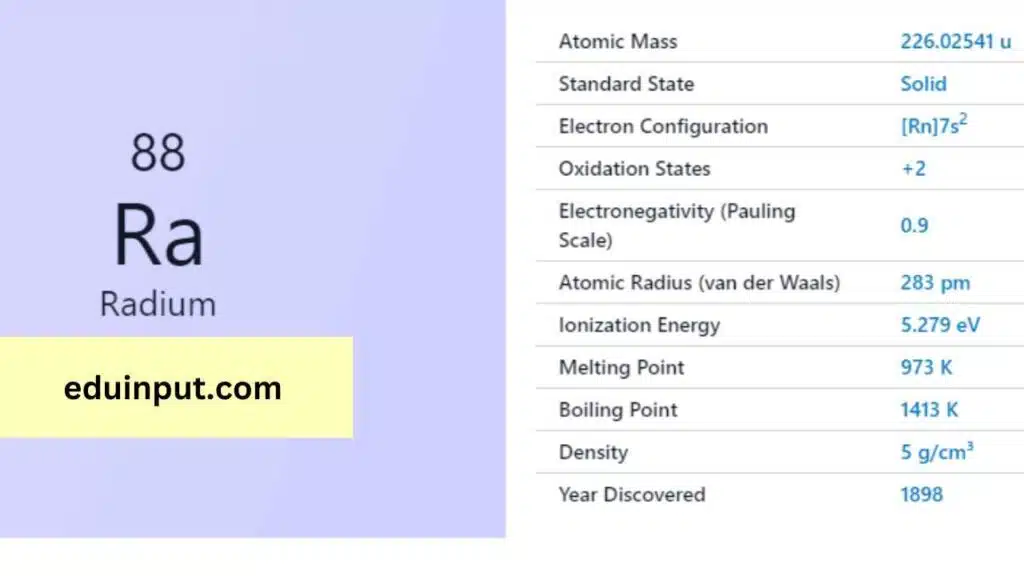Radium-Discovery, Properties, And Applications
Radium is a chemical element with the symbol ‘Ra’ and atomic number 88. It is a highly radioactive element that was discovered in 1898 by Marie Curie and her husband Pierre Curie. Radium has a unique set of properties that have made it useful in a variety of fields, from medicine to industry.

| Property | Value |
| Name | Radium |
| Symbol | Ra |
| Atomic number | 88 |
| Relative atomic mass (Ar) | Period in the periodic table |
| Standard state | Solid at 298 K |
| Appearance | Metallic |
| Classification | Metallic |
| Group in periodic table | 2 |
| Group name | Alkaline earth metal |
| Block in the periodic table | 7 |
| Group in the periodic table | s |
| Shell structure | 2.8.18.32.18.8.2 |
| CAS Registry | 7440-14-4 |
Discovery
Radium was discovered by Marie Curie and Pierre Curie in 1898. The couple isolated radium from pitchblende, a mineral that contains uranium, and studied its properties extensively. They were awarded the Nobel Prize in Physics in 1903 for their work on radioactivity, which included the discovery of radium.
Physical Properties
Radium is a silvery-white metal that is highly radioactive. It is an alkaline earth metal and is similar in chemical properties to calcium. Radium has a density of 5.5 g/cm3, a melting point of 700°C, and a boiling point of 1,737°C.
Chemical Properties
Radium is a highly reactive element that readily reacts with other elements and compounds. It reacts with water and oxygen in the air to produce radium hydroxide and radium oxide, respectively. Radium also reacts with acids to produce radium salts.
Facts
- Radium is a radioactive element that decays into other elements, including radon gas.
- Radium emits alpha, beta, and gamma radiation, which can be harmful to living organisms.
- Radium was once used in a variety of consumer products, including luminous paints and clock dials.
Applications
Radium has had a range of applications in various fields, including medicine, industry, and research. Some of the major applications of radium include:
- Cancer treatment: Radium was once used in cancer treatment to kill cancer cells. However, due to its highly radioactive nature and the availability of more effective treatments, its use in medicine has been largely phased out.
- Industry: Radium has been used in the past in a variety of industrial applications, including luminous paints, luminous watch dials, and as a source of energy for radioluminescent devices.
- Research: Radium has been used extensively in scientific research to study the behavior of radioactive elements and compounds. Its unique properties have made it a valuable tool in studying the structure of atoms and molecules.
Radium is a highly radioactive element that has played an important role in a variety of fields, from medicine to industry. Its unique properties have made it a valuable tool for scientific research and its use in consumer products has left a lasting impact on society.
However, due to its potential health risks and the availability of more effective treatments, its use in medicine and industry has been largely phased out.







Leave a Reply